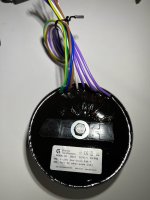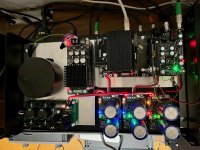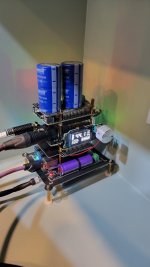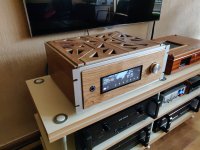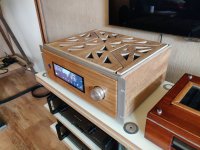I have a question about the PurePi.
If using a linear 5v, where is the input? I only see a USB C input. The manual does not mention this.
thanks
If using a linear 5v, where is the input? I only see a USB C input. The manual does not mention this.
thanks
I use an AC transformer (3x9V), dipped in resin and shielded with a metal can. The transformer powers my 2xLinearPi and 1xSalas, which in turn power 3 UCconditioners, one UCconditioner (5V) powering the StationPiPro dirty side, one UCconditioner (5V) powering the StationPiPro clean side and one UCconditioner (3.3V) powering the FifoPi Q7 clean side.
Attachments
Hi Guys, I have a question for a DIY newbie and I would like to ask for an answer here.
Built a FifoPi Q7 II + ScPure 45/49 deck in GB23.
Its SQ level takes me to new heights. Before this I used Accusilicon AS338 solution.
The problem is that I am playing the beginning of each song or fast forwarding. There is a DADA sound in the deck. The sound is like a relay or something. But in my audio experience, the relay only works when the power is turned on and off.
Hope to get help. Is this normal? The mass production of DADA sound has greatly reduced the listening quality.
thx.
Built a FifoPi Q7 II + ScPure 45/49 deck in GB23.
Its SQ level takes me to new heights. Before this I used Accusilicon AS338 solution.
The problem is that I am playing the beginning of each song or fast forwarding. There is a DADA sound in the deck. The sound is like a relay or something. But in my audio experience, the relay only works when the power is turned on and off.
Hope to get help. Is this normal? The mass production of DADA sound has greatly reduced the listening quality.
thx.
Attachments
Last edited:
last photo.
side covers now ready.
Now finish everything nicely with an aluminum strip so that it fits with the rest.
side covers now ready.
Now finish everything nicely with an aluminum strip so that it fits with the rest.
Attachments
Last edited:
Incredible work and inspiration for others.by hand jigsaw.
Hi @pkonstantinidisI use an AC transformer (3x9V), dipped in resin and shielded with a metal can. The transformer powers my 2xLinearPi and 1xSalas, which in turn power 3 UCconditioners, one UCconditioner (5V) powering the StationPiPro dirty side, one UCconditioner (5V) powering the StationPiPro clean side and one UCconditioner (3.3V) powering the FifoPi Q7 clean side.
Once again, you build looks really neat🙂
Do you also have a UcConditioner after your Salas power supply and what does that power in your stack?
Is the Salas PSU the Ultrabib 1.3 version and what current limit CCS have you set?🙂
Regards Mikkel
@miklau if I remember correctly, I have set the Salas L-adapter to provide around 5.3V to a UCconditioner (5V), which is powering the dirty side of the StationPiPro. You can set the voltage output of the L-adapter quite precisely with the help of a trimmer on the PCB.
@pkonstantinidis
Thanks🙂
I have a set of Salas ultrabib 1.3 regulators that i am not using. Just trying to see if I could incorporate one of them some how… The dirty side of the StationPi pro would also be my choice.
But not sure how much I will gain, rather than just have a single LinearPi+UcCond. PSU to power both the Rpi and q7 dirty side.
The only way is probably just to try☺️
The L-adapter look interesting to. I’ll have a look at that.
Thanks🙂
I have a set of Salas ultrabib 1.3 regulators that i am not using. Just trying to see if I could incorporate one of them some how… The dirty side of the StationPi pro would also be my choice.
But not sure how much I will gain, rather than just have a single LinearPi+UcCond. PSU to power both the Rpi and q7 dirty side.
The only way is probably just to try☺️
The L-adapter look interesting to. I’ll have a look at that.
@miklau I have not suggested that the Salas L-adapter is better or worse than the LinearPi. The L-adapter is very flexible in terms of the voltage it can supply.
To avoid any misunderstanding, I am NOT using an L-adapter and a LinearPi and a UCconditioner in series. More specifically, I use the following combinations:
a) L-adapter --> UCconditioner 5V
b) LinearPi --> UCconditioner 5V
c) LinearPi --> UCconditioner 3.3V
https://www.diyaudio.com/community/threads/gb-for-salas-l-adapter-board.338109/
To avoid any misunderstanding, I am NOT using an L-adapter and a LinearPi and a UCconditioner in series. More specifically, I use the following combinations:
a) L-adapter --> UCconditioner 5V
b) LinearPi --> UCconditioner 5V
c) LinearPi --> UCconditioner 3.3V
https://www.diyaudio.com/community/threads/gb-for-salas-l-adapter-board.338109/
H1 @pkonstantinidis
What is the overall height of the UCconditioner and a Linear PI power supply?
I'm trying to see if they will fit in my enclosure stacked on top of each other.
Thanks,
Scott
What is the overall height of the UCconditioner and a Linear PI power supply?
I'm trying to see if they will fit in my enclosure stacked on top of each other.
Thanks,
Scott
@pkonstantinidis
I understand, can you provide me with the height of the UCconditioner on its own?Thanks,
Scott
@iancanada how would you rate the LinearPi+UCconditioner against the UCpure, if we assume that UCpure gets a score of 100?
Please download the SC-Pure user's manual for the power supply selection suggestions
https://github.com/iancanada/DocumentDownload/blob/master/Clocks/SC-Pure/ScPureDatasheet.pdf
Ian
Dear Ian,
I suggest that you start a forum in the DIYaudio Vendors Forum. For example the way Twisted Pear has done. You can have separate threads for your different products to make it easier to track people’s questions. This thread has been no help to me. I have posted a few simple questions here that just get buried in the general noise.
I think you can also moderate threads that go off topic and end up full of bickering.
Please consider this, Thank You
I suggest that you start a forum in the DIYaudio Vendors Forum. For example the way Twisted Pear has done. You can have separate threads for your different products to make it easier to track people’s questions. This thread has been no help to me. I have posted a few simple questions here that just get buried in the general noise.
I think you can also moderate threads that go off topic and end up full of bickering.
Please consider this, Thank You
I'm with @pixelpusher here. Same experience.
It feels there are always the the same people having discussions here, burying other people's questions.
It feels there are always the the same people having discussions here, burying other people's questions.
@SuLim
After inserting the SC Pure, I also heard the "relay-type sound" at every song change.
I have more or less your “tower” but simpler.
As a software I use GentooPlayer and the "relay-like sounds" disappeared when I changed the kernel to RT ones.
I can't give you a technical explanation but if you use the same software I invite you to try.
I hope this indication can be of help
After inserting the SC Pure, I also heard the "relay-type sound" at every song change.
I have more or less your “tower” but simpler.
As a software I use GentooPlayer and the "relay-like sounds" disappeared when I changed the kernel to RT ones.
I can't give you a technical explanation but if you use the same software I invite you to try.
I hope this indication can be of help
Just thought I would post my build. It’s a big upgrade from the Allo digione signature I was running.

Today I finally managed to get the boards connected for a shakedown test to see if it all works.
I have not connected it to my stereo yet but was curius how the I2S signal looks like.
I installed piCorePlayer + LMS on 2 separate RPi4 and control it via the iPeng app on my iPad.
For LMS the setup looks like this: installed in an Inux3D printed chassis including space for a 2,5" SSD (1TB) which holds my music.
It is hidden near my circuit breaker panel where I also have my modem, router + switch.

piCorePlayer Setup:

Tapping into the I2S signals:

My current (old) system consists of a BBB (BeagleBone Black) and did some measurements too when I built that system some years ago.
I have shown this system already in this topic, see post #11088
For this Ian Canada set I will build a similar enclosure with a divider to protect the FifoPi Q7 + TransportPiAES as much as possible from EMI/RFI.
I will use a GPIO flat cable to connect the Q7 to the RPi4 but when passing the divider it will go through a special ferrite core:

And I also have a UCconditioner for 3.3 Volt.
From my BBB the SCK and LRCK looks nicest after the isolator to the DAC board:
Before the isolator; file is 44k1:
LRCK

SCK

After:
LRCK

SCK

When going to hi-res 192k the SCK leaves much to be desired:
Before the isolator:
LRCK

SCK

After:
LRCK

SCK

Now the IanCanada setup:
44k1: LRCK red/up and SCK yellow/down


192k: LRCK red/up and SCK yellow/down


What is also clear looking at the oscilloscope that the reclocking / very low jitter of the Ian Canada is very good ... the picture is rock solid and stable where with the old BBB the squares where jumping sideways which is the effect of jitter which is completely absent with this new set.
Once I am ready with the new cabinet and added a linear power supply as 5V main supply for the PurPi I can test the final result and hear how much improvement I get over the BBB setup.
I have not connected it to my stereo yet but was curius how the I2S signal looks like.
I installed piCorePlayer + LMS on 2 separate RPi4 and control it via the iPeng app on my iPad.
For LMS the setup looks like this: installed in an Inux3D printed chassis including space for a 2,5" SSD (1TB) which holds my music.
It is hidden near my circuit breaker panel where I also have my modem, router + switch.

piCorePlayer Setup:

Tapping into the I2S signals:

My current (old) system consists of a BBB (BeagleBone Black) and did some measurements too when I built that system some years ago.
I have shown this system already in this topic, see post #11088
For this Ian Canada set I will build a similar enclosure with a divider to protect the FifoPi Q7 + TransportPiAES as much as possible from EMI/RFI.
I will use a GPIO flat cable to connect the Q7 to the RPi4 but when passing the divider it will go through a special ferrite core:

And I also have a UCconditioner for 3.3 Volt.
From my BBB the SCK and LRCK looks nicest after the isolator to the DAC board:
Before the isolator; file is 44k1:
LRCK

SCK

After:
LRCK

SCK

When going to hi-res 192k the SCK leaves much to be desired:
Before the isolator:
LRCK

SCK

After:
LRCK

SCK

Now the IanCanada setup:
44k1: LRCK red/up and SCK yellow/down


192k: LRCK red/up and SCK yellow/down


What is also clear looking at the oscilloscope that the reclocking / very low jitter of the Ian Canada is very good ... the picture is rock solid and stable where with the old BBB the squares where jumping sideways which is the effect of jitter which is completely absent with this new set.
Once I am ready with the new cabinet and added a linear power supply as 5V main supply for the PurPi I can test the final result and hear how much improvement I get over the BBB setup.
Greetings from a fellow ASM member,Just thought I would post my build. It’s a big upgrade from the Allo digione signature I was running.
It looks like you may be powering PurePi with the linear supply. where do you input 5v to the PurePi?
The only input I see is USB-C.
Thanks, I’ve not been able to get this question answered.
Mike
@Gappone
Thank you for sharing. I will find time to familiarize myself with the operation of GentooPlayer. Currently I still use RoPieee with Daphile. Today I tried to unplug the 2-pin PH2.0 SYNC control signal line from the MonitorPi. The deck became quiet immediately. But in this way, one of its original advantages was lost. I feel regretful.- Home
- Source & Line
- Digital Line Level
- Asynchronous I2S FIFO project, an ultimate weapon to fight the jitter
